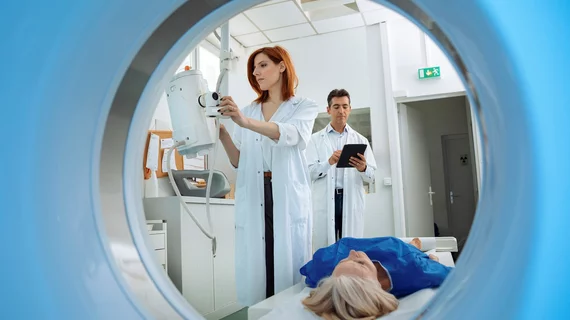AI, radiation dose and the ‘Holy Grail’ of high-quality imaging results
Radiology researchers have been spent countless hours seeking a dose-reduction technique that provides high-quality images while still limiting the patient’s exposure to ionizing radiation as much as possible. According to a new analysis published in the Journal of the American College of Radiology, AI could potentially provide imaging specialists with the perfect solution to this problem: deep learning-based algorithms.
“Traditionally, filtered back projection has been the leading algorithm for CT image reconstruction due to its short reconstruction time and computational efficiency enabling real-time image reconstruction during patient scanning,” explained Avinash Kambadakone, MD, DNB, Massachusetts General Hospital in Boston. “However, in low-dose settings and in patients with large body habitus, there is deterioration of image quality due to higher image noise and beam hardening artifacts. This led to the development of iterative reconstruction (IR) algorithms, which rely on nonlinear operations in an iterative fashion.”
IR algorithms, however, aren’t always effective. They also sometimes associated with a “blotchy,” “artificial” look that specialists dislike, Kambadakone explained, and there are some instances—low-contrast tasks, for example—when IR’s ability to reduce radiation dose is “limited.”
This is where AI comes in. Researchers have found that deep learning-based algorithms have the ability to strike that perfect balance between high image quality and low radiation dose. One AI approach described by Kambadakone involves “training convolutional neural networks with low-dose CT images using image-space based reconstructions to reconstruct standard-dose CT images.” Another technique requires the implementation of “more complex functions in IR algorithms using deep learning-based methods.”
Such methods have proven to be quite effective so far, and Kambadakone described the early results as “promising.” However, he noted, more studies are still clearly needed at this stage. Researchers must be careful; moving forward with these techniques without the proper validation would be a significant mistake.
“Although radiation dose-reduction efforts are essential, it is imperative that the diagnostic performance of a CT scan, and thereby the ability of a radiologist to confidently answer the relevant clinical problem, is not compromised,” Kambadakone concluded. “The use of AI in image reconstruction provides an invaluable opportunity to achieve the Holy Grail of high-image quality at low radiation dose, and the era of ultra-low-dose sub-millisievert CT scans might not be a distant dream.”

